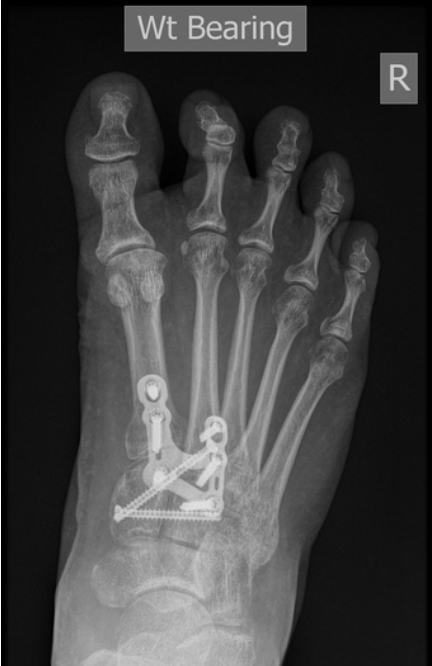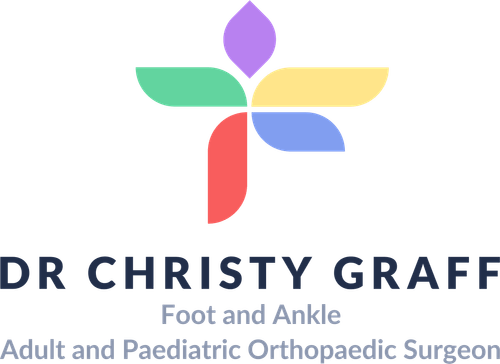Lisfranc Stabilisation
What is Lisfranc Stabilisation?
Lisfranc stabilisation is a surgical procedure used to treat injuries or instability in the Lisfranc joint complex in the midfoot. The Lisfranc joint refers to the region where the long bones of the foot (metatarsals) connect with the bones in the foot's arch (tarsal bones). This area is critical for weight-bearing, balance, and foot stability.
Injuries to this joint, known as Lisfranc injuries, can result from trauma like falls, sports accidents, or motor vehicle accidents. These injuries may involve ligament tears, fractures, or dislocations. If left untreated or improperly managed, Lisfranc injuries can lead to chronic pain, arthritis, and long-term disability.

What Conditions Does Lisfranc Stabilisation Help?
Lisfranc Stabilisation helps in cases of Lisfranc injuries, i.e. injuries to the midfoot region, affecting the arch of the foot and the metatarsal bones.
Why is Lisfranc Stabilisation Required?
This procedure is required to prevent chronic pain, instability, and foot deformity. Without stabilisation, the midfoot will collapse, causing changes in foot biomechanics. This can lead to arthritis, progressive deformity, and chronic pain.
Indications for Lisfranc Stabilisation
Lisfranc Stabilisation surgery is required for almost all lisfranc injuries except for very mild strains or chronic injuries in older patients without symptoms.
Benefits of Lisfranc Stabilisation
- Pain Relief: Reduces or eliminates pain caused by instability or arthritis in the Lisfranc joint.
- Restored Functionality: Helps regain normal foot movement and strength, enabling a return to daily activities and sports.
- Improved Stability: Restores alignment and stabilises the midfoot, reducing the risk of further injuries.
- Prevention of Arthritis: Minimises the likelihood of developing post-traumatic arthritis by addressing joint misalignment and instability.
- Prevention of deformity: MInimises the likelihood of collapse of the midfoot
- Long-Term Recovery: Promotes proper healing, leading to better long-term outcomes and reduced risk of disability.
Types of Lisfranc Stabilisation
- Open Reduction and Internal Fixation (ORIF): Involves realigning the bones and stabilising them with screws, plates, or wires. This method is commonly used for fractures or dislocations.
- Primary Arthrodesis (Fusion): Fuses the affected joints to eliminate movement and pain. It is often recommended for severe injuries or cases with advanced arthritis.
- External Fixation: Utilises an external frame to stabilise the foot, often in complex or high-risk cases.
Alternative Options to Lisfranc Stabilisation
For patients who may not require or be suitable for surgery, alternative options include:
- Conservative Management:
- Immobilisation with a cast or boot for 6–8 weeks.
- Non-weight-bearing during the initial healing phase.
- Gradual return to activity under medical supervision.
- Physiotherapy: Exercises to strengthen the foot and improve mobility once initial healing occurs.
- Orthotics: Custom shoe inserts to provide support and alleviate pain.
- Pain Management: Medications such as anti-inflammatory drugs or injections (e.g., corticosteroids) to reduce pain and inflammation.
- Activity Modification: Avoiding high-impact activities that stress the midfoot.
Preparation Before Lisfranc Stabilisation
Lisfranc Stabilisation requires a preoperative medical evaluation. This evaluation consists of a complete patient history and physical examination to determine suitability for the procedure. It will also include lab tests and imaging.
Lisfranc Stabilisation Procedure
The Lisfranc Stabilisation is performed under general anesthesia. The steps include:
- Administration of general anesthesia or regional blocks to ensure the patient is comfortable and pain-free.
- A cut is made on the top of the foot to access the damaged joint.
- Displaced bones are repositioned to their correct anatomical locations.
- Fixation devices such as screws, plates, or strong sutures are used to hold the bones in place during healing.
- The incision is closed with sutures, and a sterile dressing and boot is applied.
The surgery typically lasts between 60-90 minutes.
What Should I Expect after Lisfranc Stabilisation?
The Hospital Stay
- You will wake up with a moon boot
- Your foot will be elevated overnight, and you will have antibiotics through a drip.
- You will need blood thinner medication to thin your blood and vitamin C for 6 weeks.
- You will stay in the hospital for 1-2 days with antibiotics, blood thinners, regular paracetamol, regular laxatives, regular vitamin C and stronger painkillers to take if and when required.
- You will be only allowed to touch your foot to the ground for 6 weeks
- Depending on your balance and strength, you may need rehabilitation post-operatively
- Buying a second-hand knee scooter preoperatively (you can search online) and practising at home before the surgery can be helpful; please bring it into the hospital with you. It is easier to use a knee scooter than crutches
When You Go Home
- You will need medications for pain relief; regular paracetamol (2 tablets four times a day) is recommended, as well as strong painkillers, especially at night before bed. These can have side effects of drowsiness, nausea and constipation, and other tablets to help with these side effects may be required.
- You will need blood thinning medication and vitamin C for 6 -8 weeks
- You will need a shower chair and bags to keep the moon boot dry for the first 2-3 weeks
- You will need to attend your post-op appointment in 2-3 weeks, where the wounds will be checked
- After this, you will be able to shower with a shower chair out of the boot
Lisfranc Stabilisation Rehabilitation
All patients are different. These timelines are only guides, and some patients may progress faster or slower than others.
0 - 3 Weeks
- You will be in a moon boot for 2-3 weeks; please treat this like a plaster and do not remove it.
- You can only touch your foot to the ground for balance.
- Please keep your foot elevated and out of bed for toilet only
- You will need to bag the leg for showers
- Pain relief: Please take regular paracetamol with meals and before bed; stronger painkillers are often needed, especially before bed
- Please take blood thinning medication and vitamin C 1g daily as prescribed
2 - 3 Weeks
- Post-op appointment with Dr Graff: dressings are changed, and an x-ray is taken
- You can then take the foot out of the boot for showers and bed
- You will still need to elevate the foot most of the day
- You can start static strengthening and range of motion exercises with physio
6 Weeks
- You will have an appointment with Dr Graff and an x-ray
- You can start progressive weight bearing in a boot over 6 weeks with an orthotic with a medial arch support
12 Weeks
- You will have another appointment with Dr Graff and an x-ray;
- You can start weight bearing without the boot and increased strengthening
- You will still have ongoing swelling, but you can wear normal shoes if you can fit into them (supportive sneakers are best)
- You can start swimming and cycling
6 Months
- You will have another appointment with Dr Graff and an X-ray
- You will be feeling more ‘yourself’ and improved pain relief in the foot
- The plate and screws will need to be removed with a minor surgery (day case)
- Once the wounds are healed after the plates are removed, you can start sports-specific training and increase to impact sports
12 Months
- You will have another appointment with Dr Graff and an X-ray
- If the bones are healed, you may be discharged
- It will be good to continue with the orthotic with the medial arch support
When can I drive?
- Left foot 3 weeks (if driving an automatic car)
- Right foot 6-8 weeks
When can I return to work?
- Seated work at 2-3 months
- Prolonged standing 8-12 months
- Heavy labour work 12-18 months
Lisfranc Stabilisation Prognosis
Many patients regain full function with appropriate treatment and rehabilitation. However, some may experience residual stiffness or discomfort.
Lisfranc Stabilisation Risks
As with any surgical procedure, there are potential risks:
- Infection: Though uncommon, infections can occur and may require antibiotics.
- Nerve Damage: There's a small risk of nerve injury, which could lead to numbness or tingling.
- Hardware Issues: Fixation devices might irritate and sometimes need removal.
- Arthritis Development: Despite proper treatment, arthritis can develop in the affected joints over time.
What if Lisfranc Stabilisation is Delayed?
Delaying treatment can lead to complications:
- Chronic Pain: Ongoing discomfort due to improper healing.
- Deformity: Misalignment can cause structural changes in the foot.
- Arthritis: Increased likelihood of early-onset arthritis in the midfoot.
- Functional Impairment: Difficulty walking, running, or bearing weight on the affected foot.
Timely intervention is crucial to prevent these adverse outcomes.
Useful Website
- St Vincent's Private Hospitals: Provides details on foot conditions and surgical options.
Contact Us
If you want more information or have any questions or problems, please contact Dr Graff at admin@christygraff.com or call the rooms at 0493 461 133.
